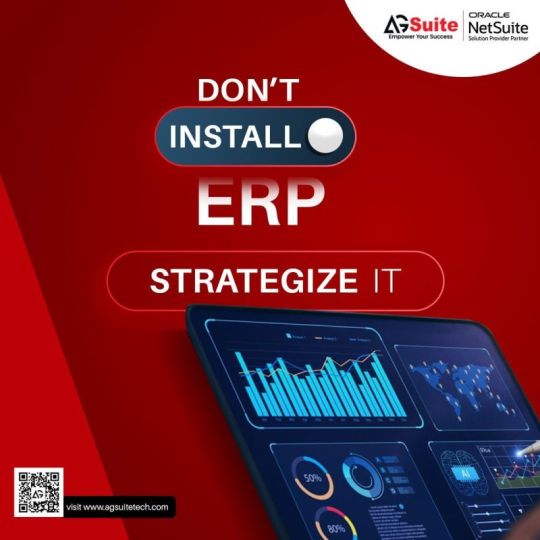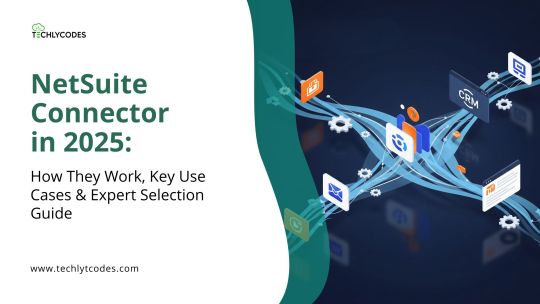#ERPStrategy
Explore tagged Tumblr posts
Text
CFOs are not techies.
But they’re held accountable for tech failures. They fight a daily battle:
Manual reports. Clunky systems. Disconnected departments. Zero real-time visibility.
All while being told, "Let’s go digital!" "Why can’t Finance move faster?"
Here’s the truth: ERP isn’t just a tool. It’s the brain of your business.
Yet most treat it like background software.
No clear ownership No integration strategy No long-term scalability plan
It’s time to shift that mindset.
Treat ERP like a strategic asset:
– Build with the future in mind. Don’t patch. Plan. – Define financial KPIs. Tie ERP to real business goals. – Invest in customization. One-size-fits-all never works. – Enable real-time insights. Stop decisions based on stale data. – Train your team continuously. Tools are only as smart as users. – Choose the right implementation partner. (Yes, this matters. A lot.)
AGSuite helps CFOs transform ERP into a growth engine. From chaos to clarity. From outdated to future-ready. From data lag to real-time decisions. See how: www.agsuitetech.com
CFOs, it’s time to lead digital finance, strategically. Not with spreadsheets. Not with silos. But with systems that scale.

#NetSuite#ERPStrategy#CFOLeadership#DigitalFinance#AGSuite#ERPTransformation#FinanceInnovation#CloudERP#ScalableSolutions#StrategicCFO
0 notes
Text

ERP implemented? Great. But are you actually getting value from it?
In 2025, smart businesses know that implementation is just the beginning. The real advantage lies in NetSuite optimization—the continuous process of aligning your ERP with how your business actually works today.
This new article explores:
• Why optimization is the difference between record-keeping and real insights • How post-implementation support helps reduce friction across departments • What managed NetSuite services can do for CFOs and COOs under pressure • Why training isn’t a one-time activity, but a long-term investment • A real-world scenario where optimization drove measurable gains
When dashboards aren’t clear, processes revert to manual, and teams stop using 60% of what NetSuite can do—that’s not ERP underperformance, that’s opportunity left on the table.
If your ERP is running... but not driving performance, this read is for you. Read the full article and explore how you can make NetSuite work smarter in 2025. https://agsuitetech.com/
#AGSuiteTech#NetSuiteOptimization#ERPStrategy#PostImplementation#ERPTraining#ManagedNetSuiteServices#CloudERP
0 notes
Text
ERP Implementation Strategies: A Guide to Successful Transformation

Implementing an ERP system can transform how your business operates, making things smoother and more efficient. But to succeed, you need the right strategy. In this blog, let’s walk through the stages of ERP implementation, explore different strategies to choose from, and help you decide which approach works best for you. Plus, learn why Oracle NetSuite is a top choice and how Integs Cloud can help you on this journey.
ERP Implementation Stages
Planning and Discovery: This is the foundation stage, where businesses define the scope, goals, and timeline for the ERP implementation. It involves identifying key stakeholders, selecting an ERP solution, and performing a thorough needs assessment.
Design: At this stage, businesses map out their processes and determine how the ERP will align with their operations. Customizations and configurations are planned here to ensure the ERP fits the unique needs of the business.
Development: The ERP solution is configured and customized based on the specific requirements. This stage also involves integrating the ERP system with existing applications, ensuring data migration strategies are in place, and building any necessary custom features.
Testing: Before going live, it’s essential to test the system rigorously. This includes functional testing, user acceptance testing (UAT), and performance testing. The objective is to identify any issues and fix them before full deployment.
Deployment: The system goes live at this stage. Businesses may choose to implement the ERP in phases (phased approach) or all at once (big bang). Proper training and user onboarding are crucial at this point to ensure a smooth transition.
Support and Optimization: Post-implementation, businesses must ensure ongoing support and optimization of the ERP system. This includes monitoring performance, making continuous improvements, and providing user support to fully leverage the ERP’s capabilities.
ERP Implementation Strategies
Big Bang Approach: The entire ERP system is deployed across all departments simultaneously. This strategy can lead to quicker results but carries higher risks, as any implementation issues can disrupt multiple areas of the business at once.
Phased Rollout: This strategy involves implementing the ERP system in phases, focusing on one module or department at a time. It minimizes risk, as the system is gradually introduced, allowing time to resolve any issues before moving to the next phase.
Parallel Adoption: The old system runs alongside the new ERP until the transition is complete. This ensures business continuity and minimizes risk, but can be more costly and resource-intensive due to the need to maintain two systems temporarily.
Hybrid Approach: A combination of the above strategies, where certain modules are implemented using the big bang approach, while others follow a phased or parallel rollout. This offers flexibility, especially for businesses with varying needs across departments.
How to Determine Which ERP Implementation Strategy Fits You
Choosing the right ERP implementation strategy depends on several factors:
Business Size: Larger businesses may benefit from a phased approach due to the complexity of operations, while smaller businesses might opt for a big bang approach to achieve quicker results.
Resource Availability: If your business has limited resources, a phased or parallel approach can help manage workloads and prevent disruptions.
Operational Risk: Businesses with high-risk operations, such as manufacturing, might prefer a phased rollout to minimize downtime and disruptions during the transition.
Time Constraints: If time is of the essence, the big bang approach can provide faster results, although it requires more intensive planning and preparation to avoid disruptions.
Why Choose Oracle NetSuite?
When it comes to choosing an ERP system, NetSuite is a game-changer. Not only does it offer a cloud-based platform with the flexibility to grow alongside your business, but it’s trusted by industry leaders.
It’s not just us saying this – 84% of companies on the Forbes Cloud 100 list are NetSuite customers. With features like real-time analytics, financial management, and supply chain solutions, Oracle NetSuite is designed to grow with your business and help you succeed.
Whether you’re a startup scaling fast or an established enterprise looking to optimize processes, NetSuite’s cloud ERP offers the agility and power you need.
Choose Integs Cloud as Your NetSuite Solution and Implementation Partner
At Integs Cloud, we specialize in delivering successful Oracle NetSuite implementations tailored to meet the unique needs of your business. With our 10+ Years of industry expertise and deep understanding of the ERP landscape, we guide businesses through every stage of the ERP implementation process, ensuring a smooth and efficient transition.
Let us help you transform your business operations and unlock the full potential of NetSuite. Partner with Integs Cloud today to embark on your ERP journey with confidence.
#ERPImplementation#NetSuitePartner#BusinessAutomation#CloudERP#DigitalTransformation#BusinessGrowth#ERPConsulting#TechSolutions#CloudTechnology#EfficiencyBoost#ProcessOptimization#BusinessSuccess#ERPStrategy#SmartBusiness#NetSuiteSolutionPartner
0 notes
Text
NetSuite Connector in 2025: How They Work, Key Use Cases & Expert Selection Guide

Is your “automated” system quietly creating more manual work behind the scenes? That’s not just frustrating — it’s a sign that the integration isn’t doing its job. Integrations used to be a technical decision. Now, they’re an operational one. In 2025, the systems your business runs on — eCommerce, CRM, 3PL, billing — need more than just basic connectivity. They need clean data flows, flexibility, and visibility across tools. That’s where the real value of NetSuite connectors comes in. Not every solution offers the same level of sync depth, logic handling, or long-term maintainability. Whether you're syncing inventory with Shopify, pushing orders to 3PLs, or aligning revenue with Salesforce — the way connectors are built (and chosen) directly impacts scale, speed, and downtime. Here is what NetSuite connectors today are expected to: – Handle high-volume transactions without delays – Manage both one-way and two-way sync based on context (orders vs. inventory vs. invoices) – Respect native NetSuite rules — not override them – Be adaptable to edge cases like split shipments, partial refunds, or custom tax logic – Avoid hard dependencies on third-party formats And most importantly: they can’t become a new bottleneck. Teams often realize this only after implementation — when sync conflicts start breaking processes that used to work. That’s why connector evaluation now needs input from ops, finance, and engineering, not just IT or vendors. Whether you use native integrations, SuiteApps, or middleware like Celigo or Boomi — what matters is the connector’s ability to mirror real-world workflows, not just move data between fields. If you're in the process of scaling, consolidating systems, or evaluating new tools — this is worth thinking through. Want to explore further, check this out: https://techlycodes.com/netsuite-connector-in-2025-how-they-work-key-use-cases-expert-selection-guide/ #NetSuite #NetSuiteIntegration #SystemIntegration #ERPStrategy #Automation #ERPIntegration #TechlyCodes #NetSuiteSupport #CloudERP
#netsuite#ecommerce#oracle#suitecommerce#business news#erp#enterprise resource planning#erp implementation#netsuite integration#netsuite support services
0 notes
Link
Hi All,
Check our latest video on 4 Simple Steps To an Effective ERP Strategy. Please comment, like, Share and subscribe to our YouTube channel.
https://youtu.be/dHRIEdwGLKQ
#ERP #Software #letosys #softwaredevelopment #ERPStrategy #ERPSolutions #ERPSystem #TuesdayThoughts
0 notes